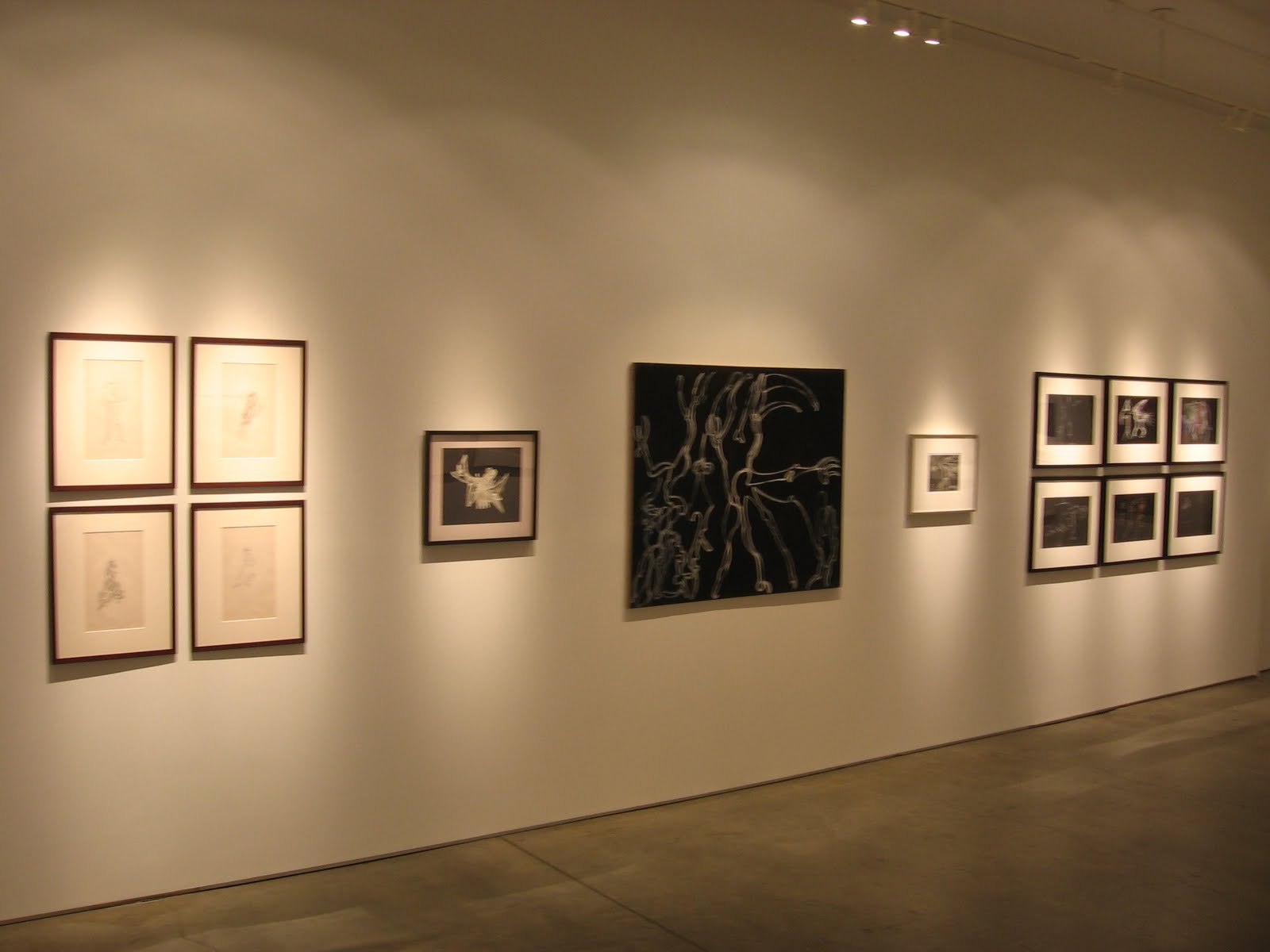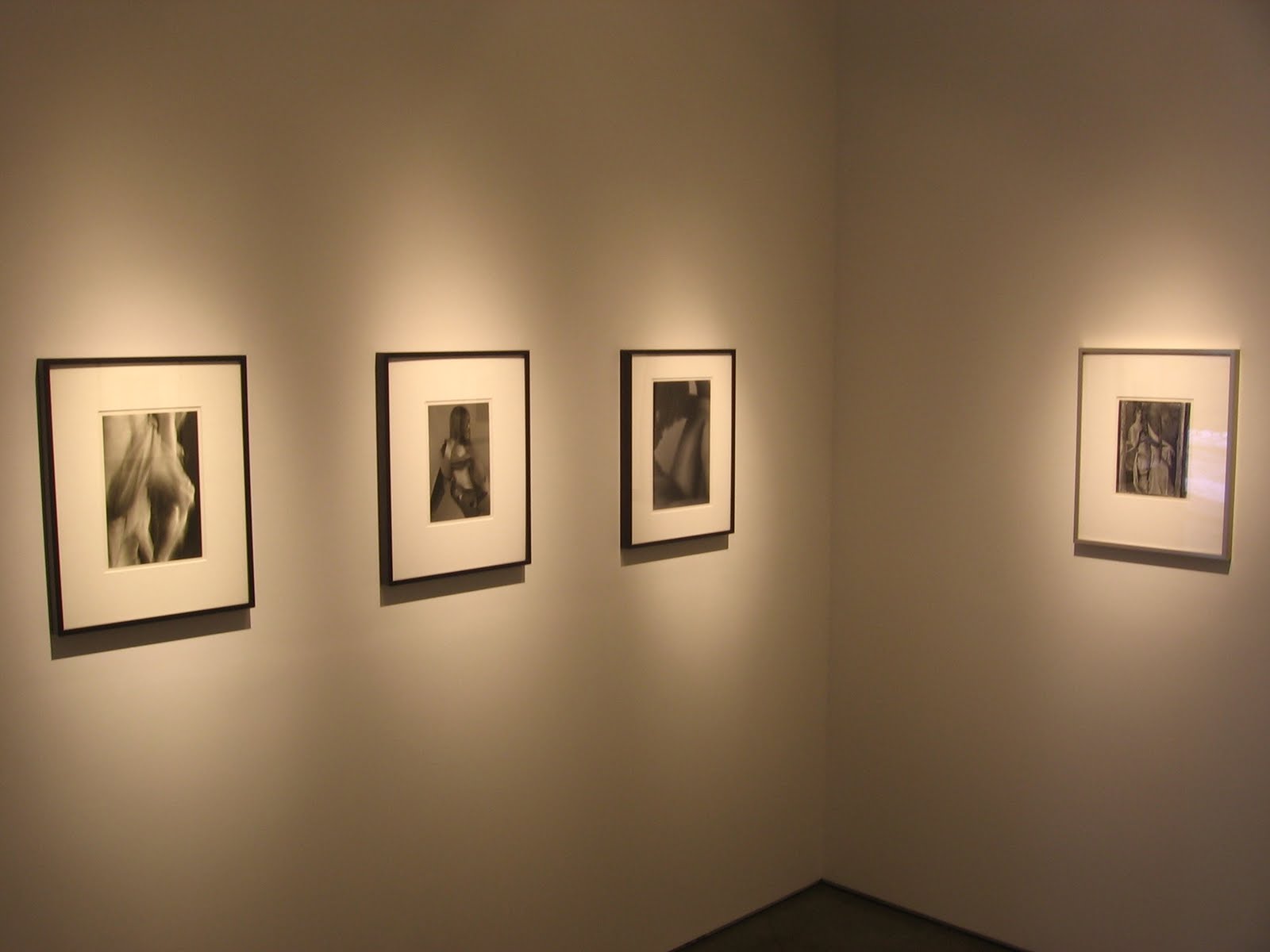 JTF (just the facts): A total of 69 works, variously framed and matted, and hung throughout the entire gallery, including the entry, front room, main space, and back room. The exhibition includes 21 black and white photographs (a mix of vintage and later gelatin silver prints), 32 drawings/prints/musical scores, 11 collages, and 5 paintings. The works span more than sixty years, from 1932 to 1998, and have been provided by the Frederick & Frances Sommer Foundation. An exhibition catalogue has been produced by the gallery and is available for $50. (Installation shots at right.)
JTF (just the facts): A total of 69 works, variously framed and matted, and hung throughout the entire gallery, including the entry, front room, main space, and back room. The exhibition includes 21 black and white photographs (a mix of vintage and later gelatin silver prints), 32 drawings/prints/musical scores, 11 collages, and 5 paintings. The works span more than sixty years, from 1932 to 1998, and have been provided by the Frederick & Frances Sommer Foundation. An exhibition catalogue has been produced by the gallery and is available for $50. (Installation shots at right.)
.
Comments/Context: If we look at a spectrum of artists who employ a camera for image making, at one end we might place those who are single-minded in their use of photography, and at the other, those who use a variety of mediums for their artistic expression, with photography as just one of many ways to make a picture. For those at the multivalent end of the continuum, depending on which of their chosen mediums becomes most recognized or “successful”, these artists often get categorized as single medium artists, even though they continue to use multiple methods tailored to specific circumstances or aesthetic goals.
. Frederick Sommer is one of those multi-talented artists who got branded a “photographer” from an early point in his career, thereby marginalizing, at least from the point of the world at large, the rest of his artistic endeavors. This museum quality retrospective exhibit makes a substantial effort to rebalance the Sommer narrative, to highlight the strengths of the photography, but in the context of Sommer’s equally innovative drawing, printmaking, collage, and painting. The picture that emerges is less of Sommer as the master photographer, but more of Sommer as a gifted artist who was exploring a variety of cutting edge, interconnected themes and ideas, probing the edges of the various available mediums to try and match his visual problems with the method that would most effectively be used to solve them.
Frederick Sommer is one of those multi-talented artists who got branded a “photographer” from an early point in his career, thereby marginalizing, at least from the point of the world at large, the rest of his artistic endeavors. This museum quality retrospective exhibit makes a substantial effort to rebalance the Sommer narrative, to highlight the strengths of the photography, but in the context of Sommer’s equally innovative drawing, printmaking, collage, and painting. The picture that emerges is less of Sommer as the master photographer, but more of Sommer as a gifted artist who was exploring a variety of cutting edge, interconnected themes and ideas, probing the edges of the various available mediums to try and match his visual problems with the method that would most effectively be used to solve them.
.
 Connections like these are all over this exhibit. One wall connects a painting with a pair of glue drawings, only to have these ideas reappear further along the wall in photographs of smoke on glass and cut paper made decades later. Another wall contains a series of Sommer’s abstracted musical scores, where the score itself is transformed from specific notation into an open ended expression of layers, lines, and curves; hung amidst these scores is a 1950s photograph of architectural arches, echoing the multiple voices and harmonies of the fictitious music. In the front room, early 1940s photographs of groups of puzzling found objects are juxtaposed with 1990s cut paper collages (mostly made from 19th century hand drawn anatomical diagrams), both exhibiting a staggering density of layered ideas, as well as painstaking attention to detail. The back room takes these ideas further, bringing together Surrealist skipreading (embodied in text heavy graphic prints), skeletons, and complete abstractions of the Arizona landscape – all looking for new ways to find meaning in easily recognized materials.
Connections like these are all over this exhibit. One wall connects a painting with a pair of glue drawings, only to have these ideas reappear further along the wall in photographs of smoke on glass and cut paper made decades later. Another wall contains a series of Sommer’s abstracted musical scores, where the score itself is transformed from specific notation into an open ended expression of layers, lines, and curves; hung amidst these scores is a 1950s photograph of architectural arches, echoing the multiple voices and harmonies of the fictitious music. In the front room, early 1940s photographs of groups of puzzling found objects are juxtaposed with 1990s cut paper collages (mostly made from 19th century hand drawn anatomical diagrams), both exhibiting a staggering density of layered ideas, as well as painstaking attention to detail. The back room takes these ideas further, bringing together Surrealist skipreading (embodied in text heavy graphic prints), skeletons, and complete abstractions of the Arizona landscape – all looking for new ways to find meaning in easily recognized materials.
 The reason this show is important is that it broadens the story of Sommer’s art beyond his cult follwing by a devoted minority and his veneration as one of the greatest photographic printers of all time. While this part of the story is still altogether true (take a close look at the prints for a breathtaking display of virtuosity), I came away with a much deeper understanding of all that Sommer was trying to accomplish during his long career. My conclusion is that Sommer was even more radical and talented than I had imagined; the back story makes the photographs stronger and gives them a more complete foundation. This is the first can’t miss show of 2010, as it takes what we know about one of the masters of the medium and explodes it outward, encompassing a much more complicated and interrelated view of how the visual ideas he was exploring eventually resulted in his many original and iconic photographs.
The reason this show is important is that it broadens the story of Sommer’s art beyond his cult follwing by a devoted minority and his veneration as one of the greatest photographic printers of all time. While this part of the story is still altogether true (take a close look at the prints for a breathtaking display of virtuosity), I came away with a much deeper understanding of all that Sommer was trying to accomplish during his long career. My conclusion is that Sommer was even more radical and talented than I had imagined; the back story makes the photographs stronger and gives them a more complete foundation. This is the first can’t miss show of 2010, as it takes what we know about one of the masters of the medium and explodes it outward, encompassing a much more complicated and interrelated view of how the visual ideas he was exploring eventually resulted in his many original and iconic photographs.- Drawings/prints/musical scores: $4500 to $20000
- Photographs: $10000 to $90000, with two NFS
- Collages: $12000 to $30000
- Paintings: $60000 to $70000
 Sommer’s photographs are often available in the secondary markets at this point, with prices ranging between $5000 and $85000 in recent years; his well known portrait of Livia (the girl with the mesmerizing stare) is the single image that drives the top end of the market.
Sommer’s photographs are often available in the secondary markets at this point, with prices ranging between $5000 and $85000 in recent years; his well known portrait of Livia (the girl with the mesmerizing stare) is the single image that drives the top end of the market. - Artist/estate site (here)
- Philadelphia MoA, 2009 (here)
- Getty, 2005 (here)
- Book: The Art of Frederick Sommer (here)
New York, NY 10011





3 stars, way to go Bruce!